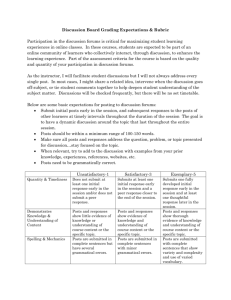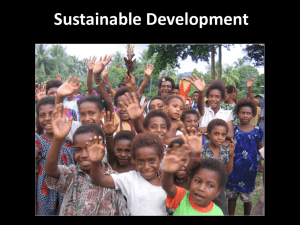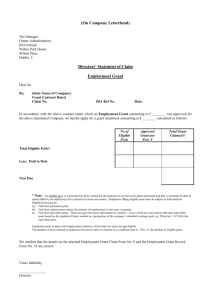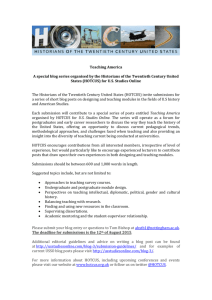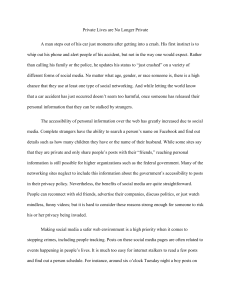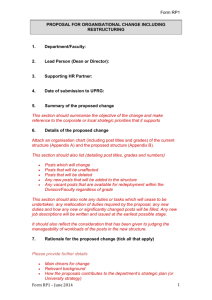EXTERNAL SERVICES RELEVANT AVAILABLE EPIDEMIOLOGY
advertisement
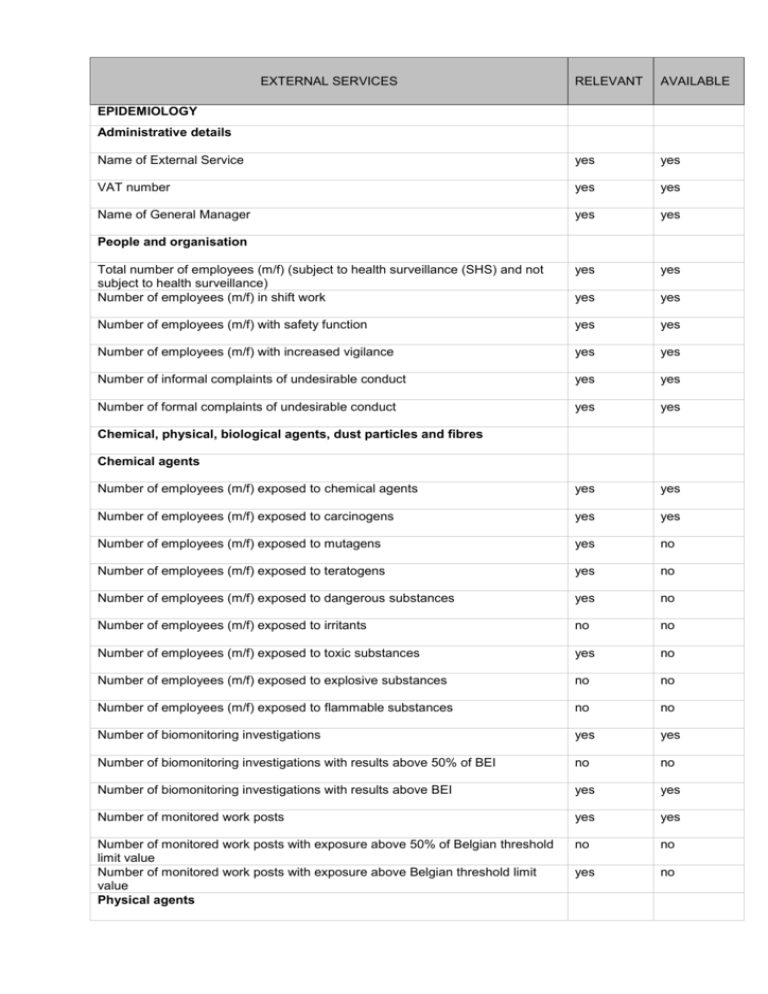
EXTERNAL SERVICES RELEVANT AVAILABLE Name of External Service yes yes VAT number yes yes Name of General Manager yes yes Total number of employees (m/f) (subject to health surveillance (SHS) and not subject to health surveillance) Number of employees (m/f) in shift work yes yes yes yes Number of employees (m/f) with safety function yes yes Number of employees (m/f) with increased vigilance yes yes Number of informal complaints of undesirable conduct yes yes Number of formal complaints of undesirable conduct yes yes Number of employees (m/f) exposed to chemical agents yes yes Number of employees (m/f) exposed to carcinogens yes yes Number of employees (m/f) exposed to mutagens yes no Number of employees (m/f) exposed to teratogens yes no Number of employees (m/f) exposed to dangerous substances yes no Number of employees (m/f) exposed to irritants no no Number of employees (m/f) exposed to toxic substances yes no Number of employees (m/f) exposed to explosive substances no no Number of employees (m/f) exposed to flammable substances no no Number of biomonitoring investigations yes yes Number of biomonitoring investigations with results above 50% of BEI no no Number of biomonitoring investigations with results above BEI yes yes Number of monitored work posts yes yes Number of monitored work posts with exposure above 50% of Belgian threshold limit value Number of monitored work posts with exposure above Belgian threshold limit value Physical agents no no yes no EPIDEMIOLOGY Administrative details People and organisation Chemical, physical, biological agents, dust particles and fibres Chemical agents Number of employees (m/f) exposed to physical agents yes yes Number of employees (m/f) exposed to noise levels greater than 80dB yes yes Number of employees (m/f) exposed to vibrations yes yes Number of employees (m/f) exposed to ionising radiation yes yes Number of employees (m/f) exposed to non-ionising radiation yes yes Number of employees (m/f) exposed to over/underpressure yes yes Number of employees (m/f) exposed to electromagnetic fields yes yes Number of monitored work posts exposed to noise yes yes Number of monitored work posts exposed to noise levels greater than 80 dB yes no Number of monitored work posts exposed to noise levels greater than 85 dB yes no Number of monitored work posts exposed to noise levels greater than 87 dB yes no Number of monitored work posts exposed to vibrations yes no Number of monitored work posts exposed to vibrations above 50% of Belgian threshold limit value Number of monitored work posts exposed to vibrations above Belgian threshold limit value Number of monitored work posts exposed to ionising radiation no no yes no yes no Number of monitored work posts exposed to non-ionising radiation yes no Number of monitored work posts exposed to ionising radiation above 50% of Belgian threshold limit value Number of monitored work posts exposed to non-ionising radiation above 50% of Belgian threshold limit value Number of monitored work posts exposed to ionising radiation above Belgian threshold limit value Number of monitored work posts exposed to non-ionising radiation above Belgian threshold limit value Number of monitored work posts exposed to over/underpressure no no no no no no no no no no Number of monitored work posts exposed to electromagnetic fields no no Number of employees (m/f) vaccinated against hepatitis A yes yes Number of employees (m/f) vaccinated against hepatitis B yes yes Number of employees (m/f) vaccinated against chickenpox no no Number of employees (m/f) vaccinated against influenza no yes Number of employees (m/f) vaccinated against tetanus yes yes Number of employees (m/f) exposed to particulate matter and nanoparticles yes no Number of employees (m/f) exposed to asbestos fibres yes yes Biological agents Dust particles and fibres Number of employees (m/f) exposed to man-made mineral fibres yes yes Number of monitored work posts exposed to particulate matter and nanoparticles yes no Number of monitored work posts exposed to particulate matter above 50% of Belgian threshold limit value Number of monitored work posts exposed to particulate matter above Belgian threshold limit value Number of monitored work posts with asbestos fibres no no no no yes yes Number of monitored work posts exposed to asbestos fibres above 50% of Belgian threshold limit value Number of monitored work posts exposed to asbestos fibres above the Belgian threshold limit value Number of monitored work posts with man-made mineral fibres no no yes no no no Number of monitored work posts exposed to man-made mineral fibres above 50% of Belgian threshold limit value Number of monitored work posts exposed to man-made mineral fibres above the Belgian threshold limit value Equipment and materials no no no no Number of employees (m/f) working with VDU yes yes Number of ergonomically analysed VDU posts yes no Number of ergonomically analysed VDU posts with health risks as a result of setup Lifting loads no no Number of employees (m/f) exposed to lifting loads yes yes Number of ergonomically analysed work posts yes no Number of ergonomically analysed work posts with health risks as a result of setup Work environment no no Number of monitored work posts with light or lighting risks yes yes Number of work posts with a luminance read-out below the threshold limit value no yes Number of monitored work posts in cold/hot conditions yes no Number of monitored work posts with WBGT read-out above/under threshold limit value Additional information no no Number of employees (m/f) with permanent unfitness for work yes yes Number of employees (m/f) with temporary unfitness for work yes yes Number of employees (m/f) with adapted work yes yes VDUs Light and lighting Temperature: cold/hot Fitness for work Number of employees (m/f) sent for further examinations yes no Number of employees (f) removed for maternity protection yes yes Describe new procedures yes no Describe new working conditions no no Describe new dangers and risks yes no Number of employees (m/f) exposed to new risks no no Number of employees (m/f) who are taking or have taken medication for a mental disorder Number of employees (m/f) who are taking or have taken medication for neoplasms Number of employees (m/f) who are taking or have taken medication for endocrine, metabolic or immunological disorders Number of employees (m/f) who are taking or have taken medication for a disorder of the blood or blood-forming organs Number of employees (m/f) who are taking or have taken medication for a complication during pregnancy or labour Number of employees (m/f) who are taking or have taken medication for a disease of the skin or subcutaneous tissue Number of employees (m/f) who are taking or have taken medication for a disease of the nervous system or sensory organs Number of employees (m/f) who are taking or have taken medication for a disease of the blood or lymphatic system Number of employees (m/f) who are taking or have taken medication for a musculoskeletal disorder or disorder of the connective tissue Number of employees (m/f) who are taking or have taken medication for an infectious or parasitic disorder Number of employees (m/f) who are taking or have taken medication for a disease of the digestive system Number of employees (m/f) who are taking or have taken medication for a urogenital disease Number of employees (m/f) who are taking or have taken medication for a respiratory disease Sick leave no no no no no no no no no no no no no no no no no no no no no no no no no no Number of employees (m/f) on sick leave as a result of a mental disorder no no Number of employees (m/f) on sick leave as a result of a neoplasm yes no Number of employees (m/f) on sick leave as a result of an endocrine, metabolic or immunological disorder Number of employees (m/f) on sick leave as a result of disorders of the blood or blood-making organs Number of employees (m/f) on sick leave as a result of a complication during pregnancy or labour Number of employees (m/f) on sick leave as a result of a disease of the skin or subcutaneous tissue Number of employees (m/f) on sick leave as a result of a disease of the nervous system or sensory organs Number of employees (m/f) on sick leave as a result of a disease of the blood or lymphatic system yes no yes no yes no yes no yes no yes no New risks Medication and sick leave Medication Number of employees (m/f) on sick leave as a result of a musculoskeletal disorder or disorder of the connective tissue Number of employees (m/f) on sick leave as a result of an infectious or parasitic disorder Number of employees (m/f) on sick leave as a result of a disease of the digestive system Number of employees (m/f) on sick leave as a result of a urogenital disease yes no yes no yes no yes no Number of employees (m/f) on sick leave as a result of a respiratory disease yes no Number of employees (m/f) on sick leave as a result of a disorder that cannot be reported elsewhere PERFORMANCE no no Name of External Service yes yes VAT number yes yes Name of General Manager yes yes Address of registered headquarters yes yes Phone number of registered headquarters yes yes Website URL no yes Total number of employees (m/f) yes yes Total number of new employees (m/f) no yes Total number of employees (m/f) on notice no yes Total number of certified H&S officers for Occupational Health yes yes Total number of certified H&S officers for Ionising radiation yes yes Total number of certified H&S officers for Occupational Hygiene yes yes Total number of certified H&S officers for Occupational Safety yes yes Total number of certified H&S officers for Ergonomics yes yes Total number of certified H&S officers for Psychosocial factors yes yes Total number of certified H&S officers in training for Occupational Health yes yes Total number of certified H&S officers in training for Ionising radiation yes yes Total number of certified H&S officers in training for Occupational Hygiene yes yes Total number of certified H&S officers in training for Occupational Safety yes yes Total number of certified H&S officers in training for Ergonomics yes yes Administrative details Personnel in External Service Certified Health & Safety Officers H&S officers in training Total number of certified H&S officers in training for Psychosocial factors yes yes Total number of nurses yes yes Total number of nurses with additional training yes yes Total number of assistant H&S officers yes yes Total number of assistant H&S officers with additional training yes yes Occupational hygiene yes yes Ergonomics yes yes Health yes yes Psychosocial yes yes Safety yes yes Affiliated companies (type A, B, C, D) yes yes Recently affiliated companies (type A, B, C, D) yes yes Companies on notice (type A, B, C, D) no yes Passive companies (type A, B, C, D) no no Number of (annually) SHS employees (m/f) (type A, B, C, D) yes yes Number of employees (m/f) ionising radiation (type A, B, C, D) no yes Number of (3-yearly) SHS employees (m/f) (type A, B, C, D) no yes Number of (5-yearly) SHS employees (m/f) (type A, B, C, D) no yes Number of non-SHS employees (m/f) (type A, B, C, D) yes yes yes yes Number of prior health assessments yes yes Number of periodic health assessments yes yes Number of health assessments for resumption of work yes yes H&S employees Additional courses followed (per half day) Clients External Service Companies Employees Activities of External Service Committees Number of committees attended for Health & Safety at work (type A, B, C) Health assessment (SHS, non-SHS) Number of health assessments after resumption of work yes yes Number of spontaneous health assessments yes yes Number of health assessments for re-integration yes yes Number of health assessments for maternity protection yes yes Number of health assessments for application to fund for occupational illnesses yes yes Number of health assessments for application for occupational accident yes yes Number of health assessments at request of employer yes yes Number of health assessments carried out yes yes Driving proficiency certificate yes yes Check-ups no no BB/RA Occupational hygiene (A,B,C,D companies) yes yes BB/RA Ergonomics (A,B,C,D companies) yes yes BB/RA Health (A,B,C,D companies) yes yes BB/RA Psychosocial (A,B,C,D companies) yes yes BB/RA Safety (A,B,C,D companies) yes yes Number of companies that have received no report for mandatory company visit in the last 3 years Number of SHS employees who have not undergone a health assessment in the last 2 years Registered environmental readings no yes no yes Environmental readings for physical agents yes yes Environmental readings for chemical agents yes yes Environmental readings for biological agents no no Environmental readings for dust particles and fibres yes yes Occupational hygiene course yes yes Ergonomics course yes yes Health course yes yes Psychosocial course yes yes Safety course yes yes Other health assessments Company visits/risk analyses (A,B,C,D companies) (per half day) Performance Courses (number of half work days) Information sessions (per half day) Occupational hygiene information session yes yes Ergonomics information session yes yes Health information session yes yes Psychosocial information session yes yes Safety information session yes yes Non-peer-reviewed publications no yes Peer-reviewed publications no no Participation in seminars and courses (per half day) yes yes Talk or poster contribution at seminar yes yes RELEVANT AVAILABLE VAT number no yes NACE(BEL)code no yes Type of company yes yes Name of director no yes Total number of employees (m/f) with permanent contract no yes Total number of employees (m/f) with temporary contract no yes Total number of employees (m/f) with interim contract no yes Total number of external employees (m/f) (third parties) no no Total number of employees (m/f) who have left the company this year no yes Total number of employees (m/f) recruited this year no yes Number of committees for workplace Health & Safety yes yes Education level of H&S officer yes yes Name, specialism and employment grade of internal certified H&S officers yes yes External Service for Workplace Health and Safety yes yes Name, specialism and employment grade of external certified H&S officers no yes Scientific activities INTERNAL SERVICES Administrative details Health & Safety policy List certificates, quality labels, care systems, ... (OHSAS, ISO, ...) no no Number of visits made to work place (with report) yes yes Number of risk analyses carried out (with report); Subject reported: safety, health, ergonomics, hygiene, psychosocial Courses and training yes yes VCA (safety check for contractors), first aid, emergency plan and evacuation, stop smoking, alcohol and drugs, management of unacceptable conduct, HACCP, new employees, hierarchy, lifting loads People and organisation yes no Is there a policy on psychosocial factors? yes yes Number of employees (m/f) with adapted work as a result of work accident or medical impairment Chemical, physical, biological agents yes yes Agents present: chemical agents, physical agents, biological agents, dust particles and fibres Chemical agents yes yes Chemical risks present: carcinogens, mutagens, teratogens, dangerous substances, irritants, toxic substances, explosive substances, flammable substances, environmental pollutants, particulate matter and nanoparticles Lowest prevention management level yes yes no no % work posts in reported worst-case conditions no no % work posts where personal protective equipment must be worn no no Number of employees that must wear personal protective equipment no no yes yes Highest exposure level in dB no yes Lowest prevention management level no no % work posts in reported worst-case conditions no no Vibrations present: global body vibrations, hand-arm vibrations yes yes Lowest prevention management level no no % work posts in reported worst-case conditions no no Radiation present: ionising radiation, non-ionising radiation yes yes Lowest prevention management level no no Number of employees (m/f) exposed to radiation yes yes Physical agents Physical risks present: noise, vibrations, radiation, electromagnetic fields Physical agents: Noise Physical agents: vibrations Physical agents: radiation % work posts where personal protective equipment must be worn no no Number of employees that must wear personal protective equipment no no Biological risks present: group 1, group 2, group 3, group 4 yes yes Lowest prevention management level no no % work posts in reported worst-case conditions no no Number of employees (m/f) exposed to biological agents yes yes % work posts where personal protective equipment must be worn no no Number of employees that must wear personal protective equipment no no Dust particles and fibres present: total dust particles, nanoparticles, asbestos fibres, man-made mineral fibres Lowest prevention management level yes yes no no % work posts in reported worst-case conditions no no Number of employees (m/f) exposed to dust particles and fibres no yes % work posts where personal protective equipment must be worn no no Number of employees that must wear personal protective equipment no no Present circumstances: VDUs, lifting loads, work posts and tasks where personal protective equipment must be worn Lifting loads yes no Lowest prevention management level no no % work posts in reported worst-case conditions no no Dangers present: fire and/or explosion, light and lighting, temporary mobile construction sites, temperature, height, moving parts, electricity, enclosed spaces, other, none Fire and/or explosion yes no Number of work posts with fire and/or explosion risk no no Lowest prevention management level no no % work posts in reported worst-case conditions no no Lowest prevention management level no no % work posts in reported worst-case conditions no no Biological agents Dust particles and fibres Equipment and materials Work environment Light and lighting Temporary mobile construction sites Number of temporary mobile construction sites no no Lowest prevention management level no no % work posts in reported worst-case conditions no no Number of work posts in cold/hot conditions yes yes Lowest prevention management level no no % work posts in reported worst-case conditions no no Number of work posts at great height no no Lowest prevention management level no no % work posts in reported worst-case conditions no no Number of work posts with moving parts no no Lowest prevention management level no no % work posts in reported worst-case conditions no no Number of work posts with electrical risks yes no Lowest prevention management level no no % work posts in reported worst-case conditions no no number of BA4 electricians no no number of BA5 electricians no no Number of work posts with enclosed spaces no no Lowest prevention management level no no % work posts in reported worst-case conditions no no Other risks no no Lowest prevention management level no no % work posts in reported worst-case conditions no no Temperature: cold/hot Height Moving parts Electricity Enclosed spaces Other Additional information: Describe below procedures, risks, working conditions that are not mentioned above Describe additional activities carried out in the context of health and safety at work EPIDEMIOLOGY yes yes Name of Internal Service yes yes Name of General Manager no yes Total number of employees (m/f) (subject to health surveillance (SHS) and not subject to health surveillance) Number of employees (m/f) in shift work yes yes yes yes Number of employees (m/f) with safety function yes yes Number of employees (m/f) with increased vigilance yes yes Number of informal complaints about undesirable conduct yes yes Number of complaints about undesirable conduct yes yes Number of employees (m/f) exposed to chemical agents yes yes Number of employees (m/f) exposed to carcinogens yes yes Number of employees (m/f) exposed to mutagens yes yes Number of employees (m/f) exposed to teratogens yes no Number of employees (m/f) exposed to dangerous substances no yes Number of employees (m/f) exposed to irritants no no Number of employees (m/f) exposed to toxic substances no yes Number of employees (m/f) exposed to explosive substances no no Number of employees (m/f) exposed to flammable substances no no Number of biomonitoring investigations yes yes Number of biomonitoring investigations with results above 50% of BEI no no Number of biomonitoring investigations with results above BEI no no Number of monitored work posts no no Number of monitored work posts with exposure above 50% of Belgian threshold limit value Number of monitored work posts with exposure above Belgian threshold limit value Physical agents no no no no Number of employees (m/f) exposed to physical agents yes yes Administrative details People and organisation Chemical, physical, biological agents, dust particles and fibres Chemical agents Number of employees (m/f) exposed to noise levels greater than 80dB yes yes Number of employees (m/f) exposed to vibrations yes yes Number of employees (m/f) exposed to ionising radiation yes yes Number of employees (m/f) exposed to non-ionising radiation no yes Number of employees (m/f) exposed to over/underpressure yes yes Number of employees (m/f) exposed to electromagnetic fields no no Number of monitored work posts exposed to noise no yes Number of monitored work posts exposed to noise levels greater than 80 dB no yes Number of monitored work posts exposed to noise levels greater than 85 dB no yes Number of monitored work posts exposed to noise levels greater than 87 dB no no Number of monitored work posts exposed to vibrations no no Number of monitored work posts exposed to vibrations above 50% of Belgian threshold limit value Number of monitored work posts exposed to vibrations above Belgian threshold limit value Number of monitored work posts exposed to ionising radiation no no no no no yes Number of monitored work posts exposed to non-ionising radiation no no Number of monitored work posts exposed to ionising radiation above 50% of Belgian threshold limit value Number of monitored work posts exposed to non-ionising radiation above 50% of Belgian threshold limit value Number of monitored work posts exposed to ionising radiation above Belgian threshold limit value Number of monitored work posts exposed to non-ionising radiation above Belgian threshold limit value Number of monitored work posts exposed to over/underpressure no no no no no no no no no no Number of monitored work posts exposed to electromagnetic fields no no Number of employees (m/f) vaccinated against hepatitis A yes yes Number of employees (m/f) vaccinated against hepatitis B yes yes Number of employees (m/f) vaccinated against chickenpox no no Number of employees (m/f) vaccinated against influenza no yes Number of employees (m/f) vaccinated against tetanus yes yes Number of employees (m/f) exposed to particulate matter and nanoparticles no no Number of employees (m/f) exposed to asbestos fibres yes yes Number of employees (m/f) exposed to man-made mineral fibres yes no Biological agents Dust particles and fibres Number of monitored work posts exposed to particulate matter and nanoparticles no no Number of monitored work posts exposed to particulate matter above 50% of Belgian threshold limit value Number of monitored work posts exposed to particulate matter above Belgian threshold limit value Number of monitored work posts with asbestos fibres no no no no no no Number of monitored work posts exposed to asbestos fibres above 50% of Belgian threshold limit value Number of monitored work posts exposed to asbestos fibres above the Belgian threshold limit value Number of monitored work posts with man-made mineral fibres no no no no no no Number of monitored work posts exposed to man-made mineral fibres above 50% of Belgian threshold limit value Number of monitored work posts exposed to man-made mineral fibres above the Belgian threshold limit value Equipment and materials no no no no Number of employees (m/f) working with VDU yes yes Number of ergonomically analysed VDU posts no no Number of ergonomically analysed VDU posts with health risks as a result of setup Lifting loads no no Number of employees (m/f) exposed to lifting loads yes yes Number of ergonomically analysed work posts no no Number of ergonomically analysed work posts with health risks as a result of setup Work environment no no Number of monitored work posts with light or lighting risks no no Number of work posts with a luminance read-out below the threshold limit value no no Number of monitored work posts in cold/hot conditions no no Number of monitored work posts with monitored WBGT above/under threshold limit value Additional information no no Number of employees (m/f) with permanent unfitness for work yes yes Number of employees (m/f) with temporary unfitness for work yes yes Number of employees (m/f) with adapted work yes yes Number of employees (m/f) sent for further examinations yes no VDUs Light and lighting Temperature: cold/hot Fitness for work Number of employees (f) removed for maternity protection yes yes Describe new procedures no no Describe new working conditions no no Describe new dangers and risks no no Number of employees (m/f) exposed to new risks no no Number of employees (m/f) who are taking or have taken medication for a mental disorder Number of employees (m/f) who are taking or have taken medication for neoplasms Number of employees (m/f) who are taking or have taken medication for endocrine, metabolic or immunological disorders Number of employees (m/f) who are taking or have taken medication for a disorder of the blood or blood-forming organs Number of employees (m/f) who are taking or have taken medication for a complication during pregnancy or labour Number of employees (m/f) who are taking or have taken medication for a disease of the skin or subcutaneous fibre Number of employees (m/f) who are taking or have taken medication for a disease of the nervous system or sensory organs Number of employees (m/f) who are taking or have taken medication for a disease of the blood or lymphatic system Number of employees (m/f) who are taking or have taken medication for a musculoskeletal disorder or disorder of the connective tissue Number of employees (m/f) who are taking or have taken medication for an infectious or parasitic disorder Number of employees (m/f) who are taking or have taken medication for a disease of the digestive system Number of employees (m/f) who are taking or have taken medication for a urogenital disease Number of employees (m/f) who are taking or have taken medication for a respiratory disease Sick leave no no no no no no no no no no no no no no no no no no no no no no no no no no Number of employees (m/f) on sick leave as a result of a mental disorder no no Number of employees (m/f) on sick leave as a result of a neoplasm no no Number of employees (m/f) on sick leave as a result of an endocrine, metabolic or immunological disorder Number of employees (m/f) on sick leave as a result of disorders of the blood or blood-making organs Number of employees (m/f) on sick leave as a result of a complication during pregnancy or labour Number of employees (m/f) on sick leave as a result of a disease of the skin or subcutaneous tissue Number of employees (m/f) on sick leave as a result of a disease of the nervous system or sensory organs Number of employees (m/f) on sick leave as a result of a disease of the blood or lymphatic system Number of employees (m/f) on sick leave as a result of a musculoskeletal disorder or disorder of the connective tissue no no no no no no no no no no no no no no New risks Medication and sick leave Medication Number of employees (m/f) on sick leave as a result of an infectious or parasitic disorder Number of employees (m/f) on sick leave as a result of a disease of the digestive system Number of employees (m/f) on sick leave as a result of a urogenital disease no no no no no no Number of employees (m/f) on sick leave as a result of a respiratory disease no no Number of employees (m/f) on sick leave as a result of symptoms or a disorder that cannot be reported elsewhere no no RELEVANT AVAILABLE VAT number. no no NACE(BEL)code. yes yes Type of company. yes no Name of director. yes yes Total number of employees (m/f) with permanent contract. yes yes Total number of employees (m/f) with temporary contract. no yes Total number of employees (m/f) with interim contract. no no Total number of external employees (m/f) (third parties). no no Total number of employees (m/f) who have left the company this year. no yes Total number of employees (m/f) recruited this year. no yes Number of committees for workplace health and safety. yes yes Education level of H&S officer. yes yes Name, specialism and employment grade of internal certified H&S officers. no yes External Service for Workplace Health and Safety no no Name, specialism and employment grade of external certified H&S officers no no List certificates, quality labels, care systems, ... (OHSAS, ISO, ...) no yes Number of visits made to work place (with report) no yes Number of risk analyses carried out (with report); Subject reported: safety, health, ergonomics, hygiene, psychosocial Courses and training no yes VCA (safety check for contractors), first aid, emergency plan and evacuation, stop smoking, alcohol and drugs, management of unacceptable conduct, HACCP, new employees, hierarchy, lifting loads People and organisation yes yes MIXED SERVICES Administrative details Health and Safety policy Number of employees (m/f) in shift work no yes Number of employees (m/f) with safety function no yes Number of informal complaints about undesirable conduct no no Number of formal complaints about undesirable conduct yes yes Is there a policy on psychosocial factors? yes yes Number of employees (m/f) with permanent unfitness for work yes yes Number of employees (m/f) with temporary unfitness for work no yes Number of employees (m/f) with adapted work as a result of work accident or medical impairment Chemical, physical, biological agents yes yes Agents present: chemical agents, physical agents, biological agents, dust particles and fibres, none Chemical agents no yes Chemical risks present: carcinogens, mutagens, teratogens, dangerous substances, irritants, toxic substances, explosive substances, flammable substances, environmental pollutants, particulate matter and nanoparticles Lowest prevention management level yes yes no no % work posts in reported worst-case conditions no no Number of employees (m/f) exposed to chemical agents no yes % work posts where personal protective equipment must be worn yes no Number of employees that must wear personal protective equipment no no yes yes Highest exposure level in dB no no Lowest prevention management level no no % work posts in reported worst-case conditions no no Number of employees (m/f) exposed to noise levels greater than 80dB no no Physical agents: vibrations no no Vibrations present: global body vibrations, hand-arm vibrations no no Lowest prevention management level no no % work posts in reported worst-case conditions no no Number of employees (m/f) exposed to vibrations no no Physical agents Physical risks present: noise, vibrations, radiation, electromagnetic fields Physical agents: Noise Physical agents: radiation Radiation present: ionising radiation, non-ionising radiation yes yes Lowest prevention management level no no Number of employees (m/f) exposed to radiation no no % work posts where personal protective equipment must be worn no no Number of employees that must wear personal protective equipment no no Biological risks present: group 1, group 2, group 3, group 4. yes no Lowest prevention management level no no % work posts in reported worst-case conditions no no Number of employees (m/f) exposed to biological agents no no % work posts where personal protective equipment must be worn no no Number of employees that must wear personal protective equipment no no Dust particles and fibres present: total dust particles, nanoparticles, asbestos fibres, man-made mineral fibres Lowest prevention management level no no no no % work posts in reported worst-case conditions no no Number of employees (m/f) exposed to dust particles and fibres no no % work posts where personal protective equipment must be worn no no Number of employees that must wear personal protective equipment no no Present circumstances: VDUs, lifting loads, work posts and tasks where personal protective equipment must be worn VDUs yes no Number of employees (m/f) working with VDU yes no Lowest prevention management level no no % work posts in reported worst-case conditions no no Number of employees (m/f) exposed to lifting loads no no yes no Biological agents Dust particles and fibres Equipment and materials Lifting loads Work environment Dangers present: fire and/or explosion, light and lighting, temporary mobile construction sites, temperature, height, moving parts, electricity, enclosed spaces, other, none Fire and/or explosion Number of work posts with fire and/or explosion risk no no Lowest prevention management level no no % work posts in reported worst-case conditions no no Number of work posts with light or lighting risks no no Lowest prevention management level no no % work posts in reported worst-case conditions no no Number of temporary mobile construction sites no no Lowest prevention management level no no % work posts in reported worst-case conditions no no Number of work posts in cold/hot conditions no no Lowest prevention management level no no % work posts in reported worst-case conditions no no Number of work posts at great height no no Lowest prevention management level no no % work posts in reported worst-case conditions no no Number of work posts with moving parts no no Lowest prevention management level no no % work posts in reported worst-case conditions no no Number of work posts with electrical risks no no Lowest prevention management level no no % work posts in reported worst-case conditions no no number of BA4 electricians no no number of BA5 electricians no no no no Light and lighting Temporary mobile construction sites Temperature: cold/hot Height Moving parts Electricity Enclosed spaces Number of work posts with enclosed spaces Lowest prevention management level no no % work posts in reported worst-case conditions no no Other risks no no Lowest prevention management level no no % work posts in reported worst-case conditions no no Describe new procedures no no Describe new working conditions no no Describe new dangers and risks no no Describe additional activities carried out in the context of workplace health and safety no no Other Additional information



